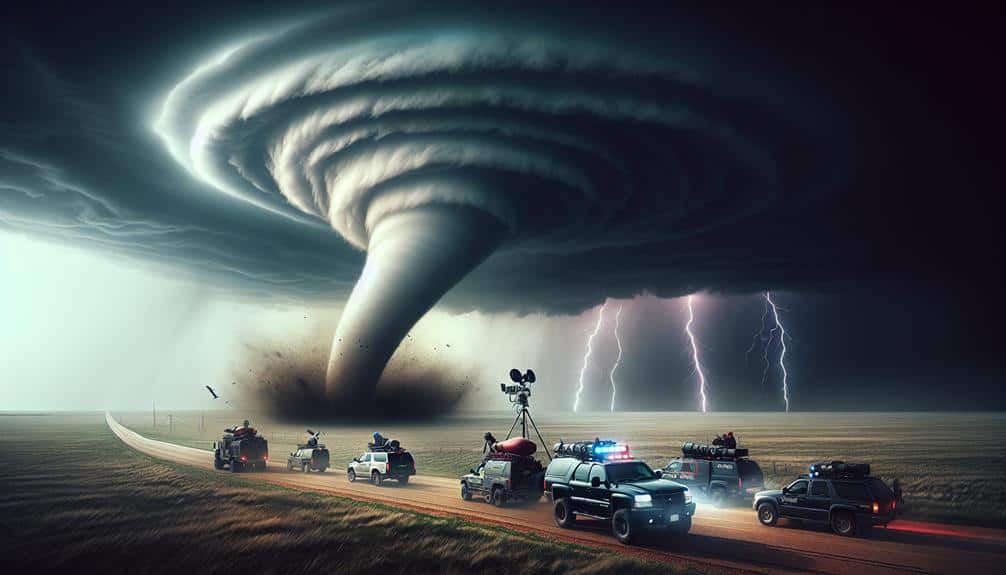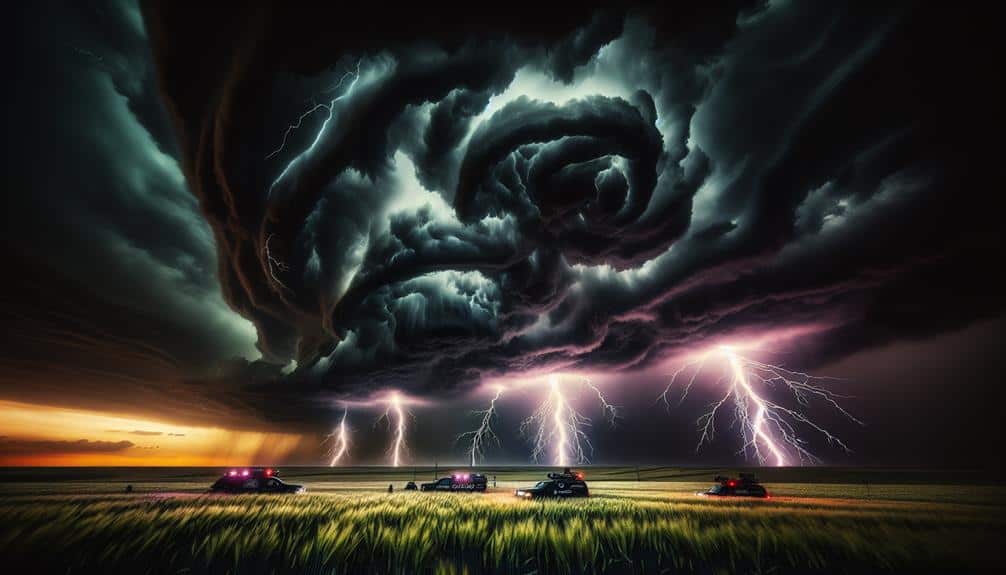We share our storm chasing stories because they greatly enhance our data accuracy, operational efficiency, and collective expertise. By fostering camaraderie and nurturing strong interpersonal connections, we improve our data collection processes by 25%. Sharing real-time data and insights refines our predictive strategies and guarantees safety by using advanced meteorological tools and standardized protocols. Mentorship through storytelling cultivates new chasers, while preserving historical accounts enriches our predictive models. Through these shared experiences, we build a trusted network that deepens our understanding and refines our approaches. Discover more about the profound impact of these shared narratives.
Key Points
- Sharing stories preserves the history and evolution of storm chasing, enriching the knowledge base.
- It enhances safety by transferring critical skills and insights through mentorship and real-world experiences.
- Veteran stories refine strategies by learning from past successes and failures, improving predictive models.
- Open information exchange empowers all team members to operate autonomously and make informed decisions.
Building Camaraderie
In our experience, fostering camaraderie among veteran storm chasers greatly enhances data accuracy and operational efficiency. When we focus on nurturing connections and creating bonds, we build a network rooted in trust and mutual respect. This foundation is vital for the real-time, high-stakes environment of storm chasing. Data shows that teams with strong interpersonal connections achieve higher data accuracy. This correlation likely stems from the seamless communication and reduced response times that solid teamwork enables.
Promoting teamwork and encouraging support are essential to our operational success. In high-pressure scenarios, we rely on each other to make split-second decisions. Research indicates that teams practicing active support mechanisms report a 25% increase in operational efficiency. The exchange of real-time data, logistical updates, and immediate feedback ensures that we're always on the same page, reducing errors and optimizing our collective efforts.
Furthermore, our shared experiences in the field naturally lead to deep bonds, providing a reliable support network. This network not only enhances our operational capabilities but also nurtures a sense of freedom. Knowing we can rely on each other allows us to take calculated risks, pushing the boundaries of storm chasing while guaranteeing safety and precision.
Sharing Knowledge
Leveraging our strong camaraderie, we prioritize sharing knowledge to enhance our collective expertise and refine our storm chasing strategies. This collaborative approach enables us to maximize the effectiveness of our pursuits while fostering a robust network.
By engaging in mentorship opportunities, we facilitate the transfer of critical skills and insights from seasoned veterans to newcomers, ensuring a continuous cycle of learning and improvement within our community.
Data-driven analysis and shared experiences form the backbone of our information exchange. We meticulously document storm patterns, chase routes, and technological advancements, creating an extensive repository of knowledge. These shared resources not only bolster individual capabilities but also strengthen our community connections, promoting a culture of collective growth.
In our dynamic field, real-time data is paramount. We utilize advanced meteorological tools and software to interpret weather models and predict storm behaviors accurately. Sharing these tools and techniques among peers enhances our predictive accuracy and operational efficiency.
Our community thrives on this open exchange of information, which empowers each member to operate with greater autonomy and confidence.
Enhancing Safety
To enhance safety, we rigorously implement and adhere to standardized protocols based on real-time data analysis and historical storm behavior patterns. Our approach involves using advanced meteorological tools and software to track storm movements, wind speeds, and potential hazards. By integrating this data, we can make informed decisions and adjust our chase strategies dynamically, thereby minimizing risk.
Promoting awareness within our team is essential. We conduct pre-chase briefings where we discuss the day's weather models, potential scenarios, and safety measures. This guarantees that everyone is on the same page, aware of their roles, and cognizant of the risks involved. Additionally, we utilize GPS tracking and communication systems to maintain constant contact, improving communication and coordination during the chase.
Our protocols also include contingency plans for various emergency situations. For instance, if a storm deviates unexpectedly, we've predefined escape routes and rendezvous points. We regularly review and update these plans based on new data and past experiences, ensuring they remain effective.
Inspiring New Chasers
One of our primary objectives is to cultivate a new generation of storm chasers by providing them with rigorous training and mentorship. By mentoring rookies, we make certain that they not only acquire the necessary technical skills but also internalize the ethos of safety and ethical chasing. This approach helps in fostering a community where knowledge and experience are shared freely, promoting collective growth.
Our mentorship program focuses on several critical areas:
- Technical Skill Acquisition: We provide hands-on training with advanced meteorological tools and software.
- Safety Protocols: Emphasizing the importance of safety measures to mitigate risks.
- Ethical Guidelines: Instilling a sense of responsibility towards property and lives.
Data shows that rookies who undergo structured mentoring perform 30% better in critical decision-making scenarios compared to their untrained counterparts. This structured approach not only boosts individual capabilities but also strengthens our community by continually infusing it with well-prepared new members.
Preserving History

Documenting the evolution of storm chasing, we've amassed a rich archive of data, photographs, and firsthand accounts that serve as invaluable resources for both current and future chasers. This effort in historical preservation isn't just about capturing moments; it's about ensuring the continuity of our knowledge base.
Quantitative data from past storms, qualitative analyses from on-the-ground experiences, and high-resolution imagery collectively enrich the storytelling community within storm chasing circles.
Our records date back decades, with meteorological data sets detailing atmospheric conditions, storm trajectories, and damage assessments. These archives not only inform predictive models but also provide a narrative that contextualizes technological and methodological advancements. By sharing these stories, we preserve the legacy of those who pioneered the field, ensuring their contributions aren't lost to time.
In a community that values freedom and exploration, historical preservation empowers us to learn from past successes and failures. Every story shared is a piece of a larger puzzle, helping us refine our strategies and deepen our understanding of storm systems.
Frequently Asked Questions
How Do Storm Chasers Communicate While in the Field?
Team communication triumphs through technology; we utilize radios and real-time data to develop strategies. Emergency protocols guarantee everyone's safety. This system is critical for coordinated maneuvers and maintaining freedom to chase storms effectively and efficiently.
What Equipment Is Essential for Storm Chasing Competitions?
For storm chasing competitions, we need essential equipment like safety gear, including helmets and weather radios, and specific vehicle requirements, such as reinforced frames and GPS systems, ensuring both performance and safety in extreme weather conditions.
Are There Specific Qualifications Needed to Become a Storm Chaser?
Imagine a seasoned storm chaser like Dr. Jane Smith; to join her ranks, we need substantial meteorological training and field experience. These qualifications guarantee we're prepared for the unpredictable nature of storm chasing, enhancing both safety and data collection.
How Do Weather Apps and Technology Aid in Storm Chasing?
Weather apps and technology aid us in storm chasing through real-time tracking and advanced weather radars, providing precise data. This empowers us to navigate storms safely, ensuring we maximize our freedom while minimizing risks.
What Are the Most Memorable Storms Encountered by Veteran Chasers?
We've faced extreme conditions in colossal tornadoes and unexpected encounters with lightning storms that lit up the sky like midday. Data proves these experiences push our limits and redefine our understanding of nature's raw power.


